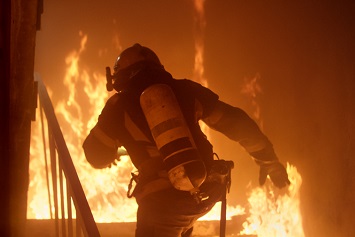The Centers for Disease Control and Prevention (CDC) will begin maintaining a firefighters’ cancer registry, trying to determine any links between workplace exposures and subsequent cancers.
The CDC’s National Institute for Occupational Safety and Health (NIOSH) is taking the lead developing and maintaining the registry. NIOSH will collect employment records from participating fire departments and attempt to link employment records to records in states’ cancer registries.
The CDC was instructed to create the registry under the Firefighter Cancer Registry Act of 2018. The act was intended to compile data on cancers occurring among volunteer, on-call, and career firefighters. The information will be available for analysis by fire services agencies and qualified researchers.
Earlier Firefighter Cancer Study
An earlier study of firefighter cancers prompted Congress to pass the act. NIOSH and the U.S. Fire Administration conducted a multi-year study from 2010 to 2015, surveying firefighters serving at fire departments in Chicago, Philadelphia, and San Francisco.
The study found that:
- Firefighters in the study had a greater number of cancer diagnoses (mostly digestive, oral, respiratory, and urinary cancers) and cancer-related deaths;
- Many were diagnosed with malignant mesothelioma, a rare type of cancer caused by exposure to asbestos (firefighters can be exposed to asbestos at fires in older homes and buildings);
- Firefighters in the study under 65 had more bladder and prostate cancers than expected;
- The chance of lung cancer diagnosis or death appeared to increase with amount of time spent at fires; and
- The chance of leukemia death appeared to increase with the number of fire runs.
Limitations of the original study included:
- Few women and minorities were in the study, limiting the ability to find any links between firefighting and cancers in those groups;
- Measurements of actual exposures (to asbestos, gases, vapors, etc.) were not available;
- Information on exposures to cancer-causing agents outside of firefighting was not available; and
- Information on lifestyle choices that are linked to cancer (such as diet, exercise, smoking habits, and alcohol use) was not available.
Despite the striking findings about increased occurrences of cancer in firefighters; researchers could not point to working fire service as a direct cause of cancer. They simply lacked enough data. Compiling such data is the purpose of the firefighter cancer registry.
Other Safety and Health Concerns
Firefighters also are exposed to excessive levels of noise during routine firefighting and emergency-response activities. Repeated exposures to noise exceeding 85 decibels (as an 8-hour time-weighted average) can lead to occupational hearing loss.
While firefighters may experience chronic conditions like cancer or noise-induced hearing loss from cumulative exposures, they also are prone to more acute safety and health concerns. These include:
- Heart disease; sudden death from a heart attack is the most common cause of death among firefighters; and
- Rhabdomyolysis, a breakdown of muscle tissue sometimes caused by hot conditions at the scene of a fire response and exertion from carrying heavy equipment and turnout gear.
What Can Fire Departments Do?
Municipal, county, and state fire service agencies can take steps to protect firefighters but sometimes must rely on firefighters to monitor and report their own conditions.
For instance, signs of rhabdomyolysis include muscle cramps and tea- or cola-colored urine. Employers can make firefighters aware of the signs of rhabdomyolysis and its risks—which include death; kidney failure, requiring lifetime dialysis or a kidney transplant; and permanent disability—but employees must self-report when they experience symptoms.
Rhabdomyolysis may require immediate medical treatment, such as intravenous (IV) fluids to flush out muscle proteins and electrolytes. Diagnosis can be confirmed with a blood test for creatine phosphokinase. However, onset can be delayed and diagnosis may require a series of blood tests.
Both structural and wild-land firefighters are at risk for rhabdomyolysis.
To prevent hearing impairment in firefighters, employers can:
- Use engineering and administrative controls to limit overall exposure to noise, and
- Provide hearing protection equipment and training when controls are impractical.
Once NIOSH has accumulated enough data in its firefighter cancer registry, it should become useful for researchers to pinpoint causes of cancers and for employers to undertake prevention measures.

